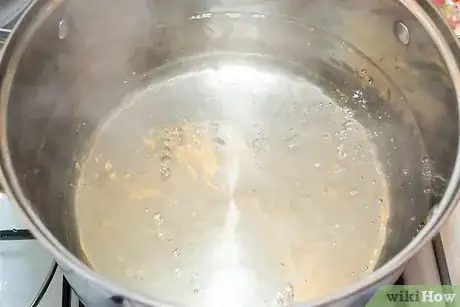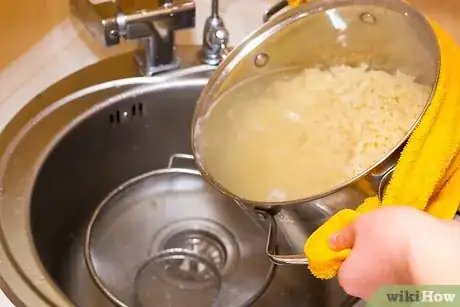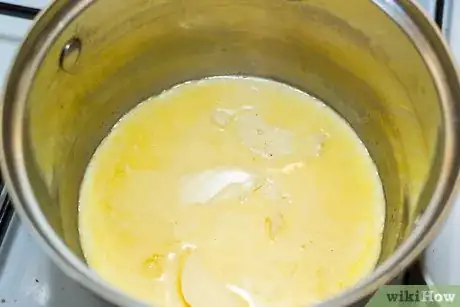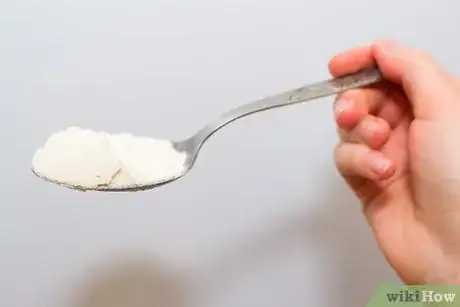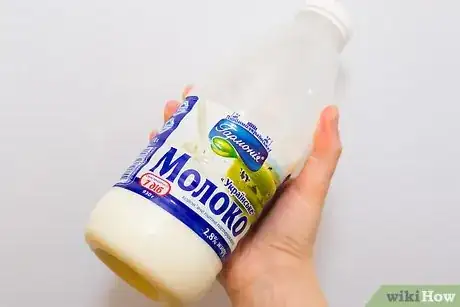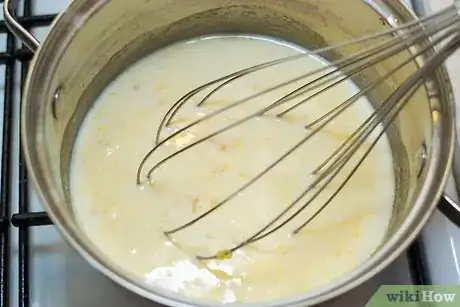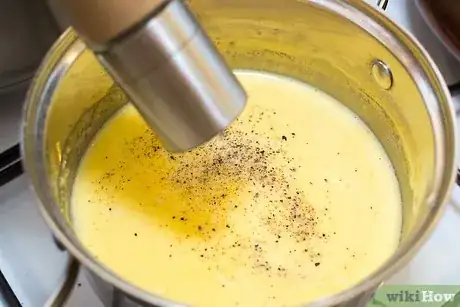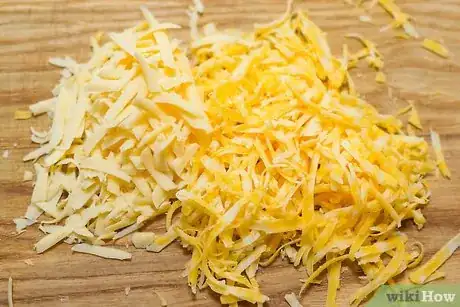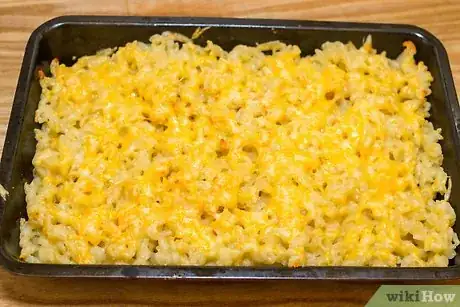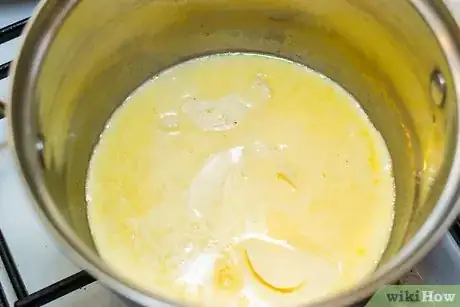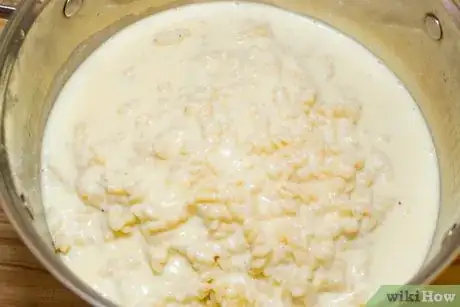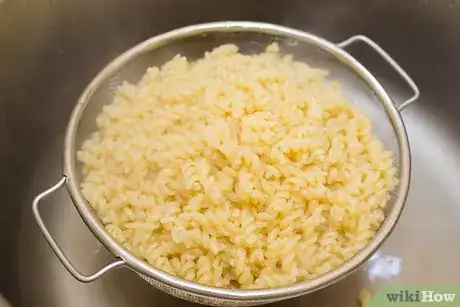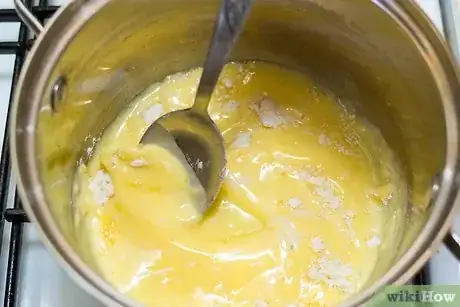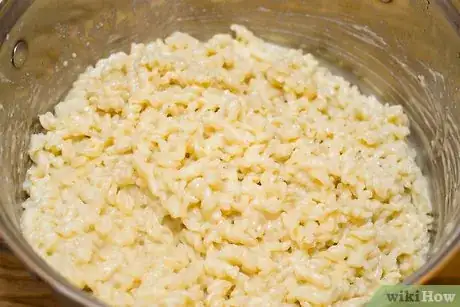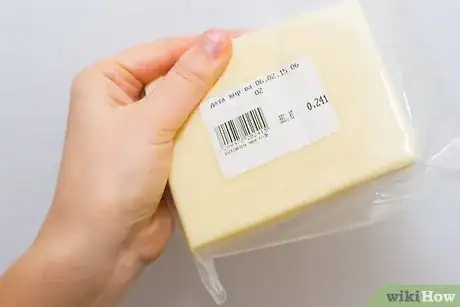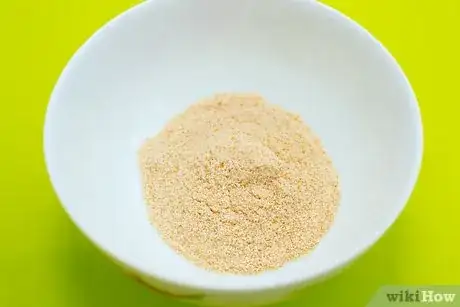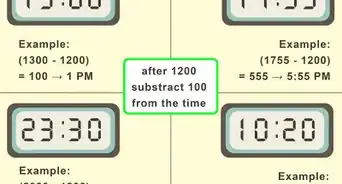This article was co-authored by wikiHow Staff. Our trained team of editors and researchers validate articles for accuracy and comprehensiveness. wikiHow's Content Management Team carefully monitors the work from our editorial staff to ensure that each article is backed by trusted research and meets our high quality standards.
This article has been viewed 13,192 times.
Nothing says comfort food like a macaroni casserole. While a good macaroni casserole is hot, cheesy, and bubbly, the variations are endless. You can use any kind of noodle, cheese, or sauce. Add meat or vegetables. Cook it in the oven, on the stove, or in the slow cooker. Whatever you do, make your macaroni casserole uniquely yours! Start with a basic recipe, choose your cooking method, and then spice it up!
Ingredients
- 12 ounces dry macaroni noodles
- 2 tablespoons unsalted butter
- 4 to 5 tablespoons all-purpose flour
- 1.5 to 2 cups milk
- 1/2 teaspoon salt, plus more for cooking noodles
- ground pepper, to taste
- 1 teaspoon dry or Dijon mustard
- 1/2 teaspoon paprika
- 2.5 cups grated cheese
Steps
Using an Oven
-
1Preheat your oven to 375 degrees. Butter a 2-quart casserole dish or 9x13" pan. This will ensure that you can easily remove the baked macaroni casserole.
-
2Boil water in a large pot. The water should rapidly boil or bubble. To get the water to boil faster, keep the pot covered.
- Season your water with salt. The noodles will absorb the flavor as they cook.
-
3Add the dry macaroni and cook. Immediately stir the noodles to keep them from clumping together. Cook the noodles for 2 to 3 minutes less than the recommended time on the package.
-
4Drain the noodles. Once the noodles are al dente, or tender to the bite, drain the noodles into a colander. Set them aside while you finish your cheese sauce.
-
5Melt the butter in a large saucepan. Start doing this while your noodles are cooking. Let the butter melt over medium heat.
-
6Make a roux by mixing in the flour. Add your flour all at once and stir well to combine it with the butter. You should cook the mixture, or roux, over medium heat for another minute to cook off the flour taste.
- The roux helps thicken your cheese sauce. If you want a really thick sauce, consider making more roux or adding additional cheese.
-
7Warm up your milk. Heat your milk in a microwave-safe bowl for a few minutes. It should be hot to the touch, but not scalding. This will make it easier to blend into your roux.
- You can add cold milk to your roux, but will need to add it very slowly. Whisk vigorously to break up any clumps of roux. It won't dissolve as quickly in cold milk as it would in hot milk.
-
8Whisk the milk into your saucepan. Gradually pour the milk into your saucepan while you constantly whisk your roux. You'll notice the roux absorb the milk, then gradually see mostly milk in your saucepan. Keep whisking over medium heat till the milk and roux are combined and no lumps remain.
-
9Season with salt, pepper, mustard, and paprika. Keep stirring your sauce till it begins to thicken a little. It should coat the back of your spoon.
-
10Stir the grated cheese into your sauce. Reserve about 1/2 a cup of cheese, but stir the rest into your sauce till it's combined.
-
11Turn off the heat and add your noodles. Depending on the size of your saucepan and pot, combine the cooked noodles and cheese sauce in whichever pot or pan is larger. Stir well, making sure that all the noodles are covered in sauce.
-
12Pour the mixture into your prepared dish. Sprinkle the top with the reserved 1/2 cup of cheese.
-
13Bake your macaroni casserole. Set a timer for 30 minutes and check to see that it's golden brown and bubbly before removing.
-
14
Using a Skillet
-
1Preheat your broiler and heat your skillet on the stovetop. You can use an 8" or 10" cast-iron or oven-safe skillet. The skillet should be over low heat.
-
2Boil water in a large pot. The water should rapidly boil or bubble. To get the water to boil faster, keep the pot covered.
- Season your water with salt. The noodles will absorb the flavor as they cook.
-
3Add the dry macaroni and cook. Immediately stir the noodles to keep them from clumping together. Cook the noodles for 2 to 3 minutes less than the recommended time on the package.
-
4Drain the noodles. Once the noodles are al dente, or tender to the bite, drain the noodles into a colander. Set them aside while you finish your cheese sauce.
-
5Melt the butter in a large saucepan. Start doing this while your noodles are cooking. Let the butter melt over medium heat.
-
6Make a roux by mixing in the flour. Add your flour all at once and stir well to combine it with the butter. You should cook the mixture, or roux, over medium heat for another minute to cook off the flour taste.
- The roux helps thicken your cheese sauce. If you want a really thick sauce, consider making more roux or adding additional cheese.
-
7Warm up your milk. Heat your milk in a microwave-safe bowl for a few minutes. It should be hot to the touch, but not scalding. This will make it easier to blend into your roux.
- You can add cold milk to your roux, but will need to add it very slowly. Whisk vigorously to break up any clumps of roux. It won't dissolve as quickly in cold milk as it would in hot milk.
-
8Whisk the milk into your saucepan. Gradually pour the milk into your saucepan while you constantly whisk your roux. You'll notice the roux absorb the milk, then gradually see mostly milk in your saucepan. Keep whisking over medium heat till the milk and roux are combined and no lumps remain.
-
9Season with salt, pepper, mustard, and paprika. Keep stirring your sauce till it begins to thicken a little. It should coat the back of your spoon.
-
10Stir the grated cheese into your sauce. Reserve about 1/2 a cup of cheese, but stir the rest into your sauce till it's combined.
-
11Turn off the heat and add your noodles. Depending on the size of your saucepan and pot, combine the cooked noodles and cheese sauce in whichever pot or pan is larger. Stir well, making sure that all the noodles are covered in sauce.
Using a Slow Cooker
-
1Butter the inside of your slow cooker. Use a 3 to 4 US-quart (3,000 to 4,000 ml) slow cooker. Buttering the dish will make it easier to remove the baked macaroni casserole.
-
2Boil water in a large pot. The water should rapidly boil or bubble. To get the water to boil faster, keep the pot covered.
- Season your water with salt. The noodles will absorb the flavor as they cook.
-
3Add the dry macaroni and cook uncovered. Immediately stir the noodles to keep them from clumping together. Cook the noodles for 2 to 3 minutes less than the recommended time on the package.
-
4Drain the noodles. Once the noodles are al dente, or tender to the bite, drain the noodles into a colander. Set them aside while you finish your cheese sauce.
-
5Melt the butter in a large saucepan. Start doing this while your noodles are cooking. Let the butter melt over medium heat.
-
6Make a roux by mixing in the flour. Add your flour all at once and stir well to combine it with the butter. You should cook the mixture, or roux, over medium heat for another minute to cook off the flour taste.
- The roux helps thicken your cheese sauce. If you want a really thick sauce, consider making more roux or adding additional cheese.
-
7Warm up your milk. Heat your milk in a microwave-safe bowl for a few minutes. It should be hot to the touch, but not scalding. This will make it easier to blend into your roux.
- You can add cold milk to your roux, but will need to add it very slowly. Whisk vigorously to break up any clumps of roux. It won't dissolve as quickly in cold milk as it would in hot milk.
-
8Whisk the milk into your saucepan. Gradually pour the milk into your saucepan while you constantly whisk your roux. You'll notice the roux absorb the milk, then gradually see mostly milk in your saucepan. Keep whisking over medium heat till the milk and roux are combined and no lumps remain.
-
9Season with salt, pepper, mustard, and paprika. Keep stirring your sauce till it begins to thicken a little. It should coat the back of your spoon.
-
10Stir the grated cheese into your sauce. Reserve about 1/2 a cup of cheese, but stir the rest into your sauce till it's combined.
-
11Turn off the heat and add your noodles. Stir well, making sure that all the noodles are covered in sauce.
-
12Sprinkle with extra cheese and broil. Use the reserved 1/2 cup of cheese and stick it underneath your broiler for 3 to 4 minutes, or until it's golden and bubbly.
-
13Dish up and let the casserole sit a few minutes. This will make it a little easier to eat and also helps the casserole set up.[3]
Spicing Up Your Macaroni Casserole
-
1Use a different noodle. Your macaroni casserole doesn't have to have macaroni noodles. Any type of tubular pasta can work. Avoid using long thin spaghetti like noodles, since they won't hold the cheesy sauce as well.
- Cavatappi, farfalle, fusilli, penne, and rotini are good examples of tubular noodles that hold a cheese sauce well.[4]
-
2Try a few cheeses. For great results, try a mixture of different cheeses. This can help build flavor and make your pasta creamier.
- Sharp cheeses work best in macaroni casserole since the milk sauce doesn't have much flavor on its own. Try Feta, Gruyere, sharp white Cheddar, or Pecorino Romano.[5]
- To create a stringy stretchy casserole, use Mozzarella or Monterey Jack.
-
3Add texture. Since macaroni casserole is pretty uniform in texture on its own, add a little crunch to mix things up. The easiest way to do this is by adding a topping.
- Try topping with a mixture of breadcrumbs and Parmesan cheese. Scatter it over top and broil or bake as directed.
- For a bigger crunch, spread large homemade croutons over your casserole and broil or bake as directed.
-
4Stir in a few additions. If you want to round out your macaroni casserole to create a more rounded meal, consider adding a few of the following:
- cooked ground beef, crumbled bacon, diced sausages, shredded chicken, flaked tuna
- steamed broccoli, sauteed mushrooms, green peas, fresh diced tomatoes, black beans
-
5Drizzle with a sauce. Add a little extra oomph to your casserole by adding a lot or a little of the following sauces:
- ketchup
- barbecue sauce
- sriracha sauce
- tabasco sauce
- sour cream
- salsa
References
- ↑ http://www.epicurious.com/recipes/food/views/Cast-Iron-Mac-and-Cheese-51100650
- ↑ http://www.marthastewart.com/271998/perfect-macaroni-and-cheese
- ↑ http://www.epicurious.com/recipes/food/views/Cast-Iron-Mac-and-Cheese-51100650
- ↑ http://pastafits.org/pasta-dictionary/
- ↑ http://www.marthastewart.com/271998/perfect-macaroni-and-cheese

